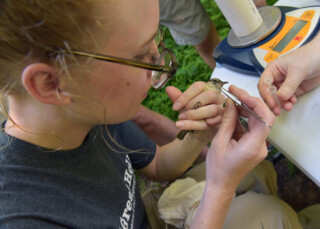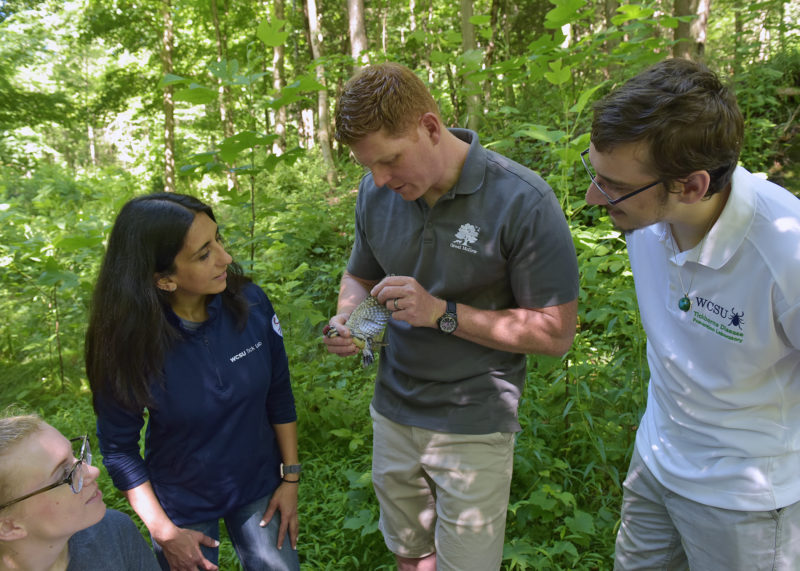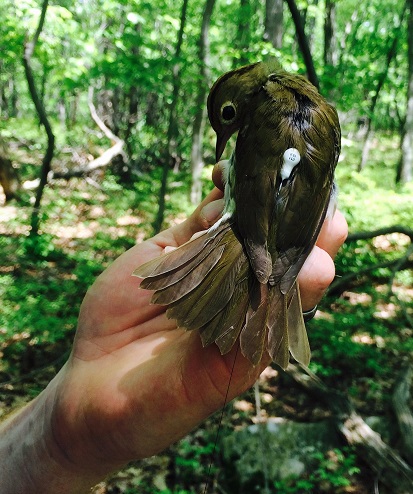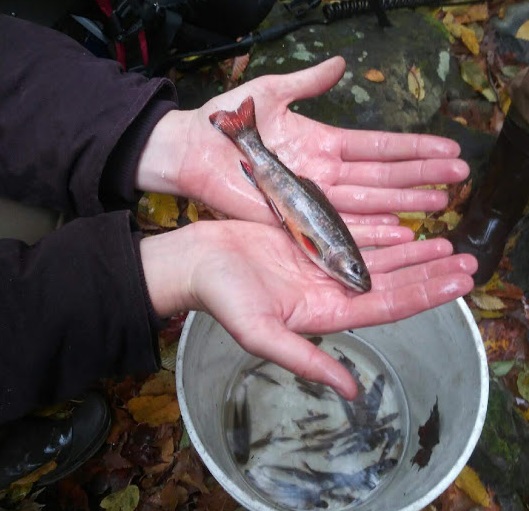Conservation science is at the center of what we do at Great Hollow. Our researchers and collaborators conduct applied studies of biodiversity in Connecticut and beyond to better understand human impacts to the environment, and provide science that can help guide management decisions and public policy. We specialize in integrating the fields of animal ecology, physiology, and toxicology to investigate the effects of introduced species, land use change, and pollution on wildlife and habitats. We take a highly collaborative approach to research, pooling and leveraging the skills and resources of partners across academia, government, and non-governmental organizations to most effectively and efficiently approach questions of common interest. Below are some of our projects.
Wood Turtle Distribution and Habitat Associations in the Catskills
Project Leads: Tara Ewers, Dr. Chad Seewagen, Dr. Sarah Deckel
The wood turtle is an imperiled freshwater turtle that is in urgent need of conservation action to reverse declines. This requires a sound understanding of where populations remain and the habitat characteristics with which they are most closely associated. Through a grant from the New York State Department of Environmental Conservation (NYSDEC), Great Hollow is assisting the agency in documenting the distribution and habitat associations of wood turtles in the Catskill Mountains. This region of New York contains an abundance of streams that have potential to support wood turtles, but the status of wood turtles in many Catskills stream systems is largely unknown. The information gained from the study will improve the ability of NYSDEC to protect wood turtles from encroaching development and other threats, and identify habitats to prioritize for protection and restoration.
Comparative Energetics of a High-Elevation Specialist and Elevational Generalist Songbird in Vermont
Project Leads: Dr. Sarah Deckel and Dr. Chad Seewagen
Bicknell’s thrush is a rare migratory songbird that nests only on the highest mountain peaks of New York, New England, and eastern Canada. It is uniquely adapted to the cold and wet climate of high-elevation zones, where few other species can also successfully breed and competition for resources is relatively low. However, climate change is altering these conditions and threatening to disrupt the current balance among species, making it important to understand what makes high-elevation specialists like Bicknell’s thrush better suited to their environment than the generalists that climate change may favor. One possibility is that the energy metabolism of Bicknell’s thrush is more efficient than that of other birds, allowing it to better thrive in the harsh conditions of mountaintops. Another possibility is that the plumage of Bicknell’s thrush is more insulative and water-repellant than that of other species, which would save energy in the face of cold temperatures and frequent precipitation. To test these hypotheses, Great Hollow is comparing the energetics and plumage water repellency of Bicknell’s thrush to the closely related Swainson’s thrush, which also nests at high elevation but in much lower abundance than downslope. In collaboration with scientists from the Vermont Center for Ecostudies (VCE), UMass-Amherst, and Old Dominion University, we are collecting feather and blood samples from Bicknell’s and Swainson’s thrushes at VCE’s long-term monitoring station on Mount Mansfield — Vermont’s tallest mountain. We are measuring an oxygen isotope, Δ’17O, in the blood samples to compare energy use between species and analyzing the “hydrophobicity” of the feather samples to compare water repellency. We are also examining energy use in relation to temperature and precipitation to investigate whether Bicknell’s thrush incurs lower energy costs than Swainson’s thrush during particularly cold and wet days and nights. The findings of the study will help us understand the threat posed to Bicknell’s thrush from Swainson’s thrush and other competitors that may further expand into high-elevation areas as a result of climate change.
Using Citizen Science to Predict the Spread of the Spotted Lanternfly in Connecticut
Project Lead: Tara Ewers
The spotted lanternfly is an invasive insect from Asia that is quickly spreading throughout the Northeast and presenting a novel threat to native trees and domestic crops — particularly grapes. The threat to grape growers comes at a time when Connecticut’s wine tourism industry is booming. Using GIS, land-cover data, and citizen-science observations of spotted lanternflies from iNaturalist, Great Hollow’s education coordinator, Tara Ewers, is mapping the current distribution of the spotted lanternfly in Connecticut and predicting when and where it is most likely to continue spreading through the state. Click here to view an interactive story map about this project (best viewed on a computer or tablet).
Effects of Japanese Barberry on Forest Songbird Habitat Quality and Diet Composition
Project Lead: Dr. Chad Seewagen
Since its introduction from Asia in the late 1800s, Japanese barberry has become one of the most widespread non-native invasive plants in Northeastern forests, and like most other non-native invasive plants, is assumed to diminish habitat quality for forest wildlife. Yet, surprisingly few studies have actually investigated the effects of Japanese barberry on the wildlife that inhabits invaded areas. Great Hollow conducted an integrative assessment of the effects of Japanese barberry on breeding habitat quality for forest songbirds, using the ovenbird as a model. The first stage of this research examined food abundance and the physiological condition of ovenbirds in breeding territories with either extensive or little to no Japanese barberry coverage, and was published in 2019 in the journal Conservation Physiology. Subsequently, we investigated differences in ovenbird diet composition between highly or minimally invaded areas of forest, using carbon and nitrogen isotope analysis, to see if barberry’s effects on arthropod communities cascade to higher trophic levels. That study was recently published in the Canadian Journal of Zoology and can be accessed here.
Effects of Japanese Barberry on Invertebrate Food Webs
Project Leads: Drs. Chad Seewagen, Robert Clark, Wales Carter
Non-native plants can negatively affect the abundance and diversity of foliage-dwelling and leaf litter invertebrates. These invertebrates play an important role in forest nutrient cycling and are a critical food source for birds and other wildlife at higher trophic levels. We conducted a study to compare invertebrate biomass, diversity, and community composition on invasive Japanese barberry to that of native plants in the forest understory and leaf litter. We found that branch-dwelling and leaf-litter arthropod communities in invaded areas are significantly different from, and less species-rich than, those where native vegetation is still dominant, although overall biomass does not differ. The study was published in 2019 in Environmental Entomology and can be read here.
Evaluating the Value of Invasive Plants as a Foraging Resource for Insectivorous Birds
Project Leads: Drs. Robert Clark and Wales Carter
Plant species differ greatly in the abundance, richness, and diversity of insects they support, with non-native, invasive plants often representing the lowest-quality hosts. This can have cascading effects up the food web, beginning with insectivores, like birds. What is not well-understood, however, is how the quality of insects as food for birds might also vary across different species of host plants. Through a bird exclusion experiment, we compared we compared arthropod biomass and quality (protein content), and bird foraging intensity among 6 native and 4 non-native tree and shrub species in our forest at Great Hollow. The results of this research were recently published here and are intended to help inform habitat management efforts that aim to benefit insectivorous birds by supporting intact, robust communities of insect prey.
Impacts of Forest Disturbance on Spring Wildflowers and their Seed-Dispersing Ant Mutualists
Project Lead: Dr. Robert Clark
Many plants produce fruits to attract birds or mammals to help disperse seeds. However, there is a relatively small group of plant species that uses ants for seed dispersal. These ant-dispersed plants, or ‘myrmecochores’, are primarily found in mature, second-growth forests and have short flowering periods in early spring. Trout Lily, Trillium, Dutchman’s Breeches, Corydalis, Spring Beauty, and Hepatica, for example, all rely on the ant species Aphaenogster for seed dispersal. There is some concern that forest fragmentation and other forms of disturbance may disrupt this important mutualism. Without spring ephemerals, Aphaenogaster may not get enough food to persist in forests, and without Aphaenogaster, spring ephemerals will not be able to effectively reproduce. This study tracked long-term changes to spring ephemeral communities to see how the mutualism responds to environmental change. We collected data on the density of ant-dispersed wildflowers at nine forests in Litchfield County, Connecticut that have varying degrees of disturbance. Following a 7-year removal experiment, we surveyed the relative abundance of the keystone mutualist Apheanogaster rudis compared to other non-seed dispersing ants at these locations. As expected, seed removal slightly reduced the relative abundance of wildflowers in those plots, but surprisingly, it did not reduce the abundance of the ants at all. Seed supplementation also didn’t increase the abundance of ants. This doesn’t necessarily mean that wildflowers aren’t important to Aphaenogaster ants, but demonstrates the ants are robust to long-term wildflower loss and disturbance, and able to get enough food from other sources when necessary. The study was published in Food Webs in 2022 and can be accessed here.
The Effects of Diet-shifting from Insects Towards Fruit on the Energetic Condition of Autumn-migrant Songbirds
Project Lead: Dr. Wales Carter
Migration is a heavily taxing period in the lives of songbirds, and acquiring sufficient energy and nutrients en route is crucial for migration success. Although many songbirds rely on insects during the breeding season, they shift to fruits in the fall, which has been proposed to support their ability to complete migratory journeys by both reducing foraging costs and providing a source of antioxidants. High levels of antioxidant consumption could be particularly useful for aiding recovery after long flights or prophylactically preventing oxidative damage to muscle during flight. Similarly, starting to consume fruits earlier in the migratory season could prevent longer-term declines in condition, particularly for species with particularly long migrations. However, the timing of diet shifts by fall migrants, and the relationship between antioxidant consumption and energetic condition, have received little study. In this project, we used stable isotope analysis of feathers, red blood cells, and blood plasma to compare timelines of diet shifts between a long- and short-distance migrant (Swainson’s thrush and hermit thrush) and relate that to measures of their condition. This work was done in collaboration with Dr. Susan Pagano of the Rochester Institute of Technology, using samples generously collected for us by the Braddock Bay Bird Observatory in New York and Powdermill Avian Research Center in Pennsylvania. Te study was published in Oecologia in 2024 and can be accessed here.
Effects of Light Pollution on Bat Activity and Community Composition
Project Lead: Dr. Chad Seewagen
Populations of many bat species have suffered dramatic declines due to the outbreak of a disease known as white-nose syndrome. Bats are also facing a series of other threats from habitat loss, wind energy development, hibernaculum disturbance, and environmental contaminants. As nocturnal animals, bats may also be adversely affected by light pollution, but this has not been well-studied in North America. It is particularly unknown how contemporary, energy-efficient lighting technologies, like LED, affect bats. In collaboration with Dr. Amanda Adams of Bat Conservation International and Texas A&M University, Great Hollow is experimentally studying the effects of LED lighting on bats at our preserve. Using an experimental array of floodlights erected along the edge of our wetland and an acoustic bat recorder that detects the echolocation calls of bats, we have so far shown that LED light pollution significantly displaces some species, but not others, from illuminated areas. This results in a significant change in the species composition of the bat community. These findings were published in 2021 in the journal Ecology and Evolution, and will help natural resources managers better evaluate potential impacts to bats from new development projects that involve nighttime lighting. We subsequently published a follow-up experiment in Global Ecology and Conservation in 2023 that documented the distances up to which LED lights have these negative effects on bats, so the full footprint of disturbance from light pollution can be better understood.
Home Ranges and Movement Patterns of Wood Turtles
Project Lead: Dr. Chad Seewagen and John Foley
Great Hollow’s naturalist, John Foley has been consistently radio-tracking wood turtles at various sites in Fairfield County, CT and Putnam County, NY for the past several years. In collaboration with Dr. Suzanne Macey at the American Museum of Natural History and Columbia University undergraduate student, Jason Hagani, we have used these data to determine the home range sizes and area requirements of male and female wood turtles in our region, and examine annual fidelity to their hibernacula and core breeding season habitats. The findings of this research were published in 2021 in Chelonian Conservation and Biology. We plant to continue monitoring these turtles to obtain the long-term data needed to determine their survivorship in the face of threats from vehicle collisions, declining stream quality, and an abundance of synanthropic predators like raccoons.
Effects of Mercury Exposure on the Behavior and Endurance Physiology of Migrating Songbirds
Project Lead: Dr. Chad Seewagen
Mercury is a global pollutant and a powerful neurotoxin that has become increasingly widespread in the environment as a result of a two- to three-fold increase in atmospheric emissions over the past 200 years. The threats of mercury pollution to fish-eating wildlife and other top predators have been well-documented, but it has recently become apparent that animals at lower positions in food webs, like songbirds, can also accumulate harmful levels of mercury. However, it is largely unknown at what level mercury begins to cause adverse effects in songbird species. We also know next to nothing about how mercury exposure might affect the ability of birds to migrate long distances. In collaboration with Drs. Chris Guglielmo, Yolanda Morbey, and Yanju Ma at the University of Western Ontario, Great Hollow scientists radio-tagged and tracked yellow-rumped warblers of differing blood mercury levels during their spring migration to investigate the effect of mercury on migration behavior and orientation. The study was published in 2019 in the Journal of Ornithology and represents the first study of the effects of mercury pollution on the migratory behavior of birds. In the second phase of this work, we tested the effects of mercury on key regulators of energy metabolism in yellow-rumped warblers to investigate whether exposure to mercury pollution might hinder the flight endurance of migratory birds. That study was published in 2022 in Scientific Reports and can be accessed here.
Birds as a Potential Dispersal Mechanism of the Asian Long-horned Tick
Project Lead: Dr. Chad Seewagen
The Asian long-horned tick is an invasive species that was first discovered in the U.S. in 2017 and has now been documented in at least 8 states, including Connecticut and New York. In its native range in Asia, the tick is a vector of hemorrhagic fever and Japanese spotted fever in humans, and is a devastating pest of livestock. It is currently unknown what threat the Asian long-horned tick presents to people, domestic animals, or wildlife in the U.S., or how far and fast it will spread. Its rapid spread through the eastern U.S. so far, however, indicates that migratory birds might be a primary mechanism by which the Asian long-horned tick is moved around. Birds are a common host of Asian long-horned ticks in Asia, but it is unknown whether North American bird species represent suitable hosts. In collaboration with Dr. Neeta Connally at Western Connecticut State University, Great Hollow is surveying various species of migratory and resident birds at our nature preserve for the presence of ticks during spring migration and the summer breeding season to investigate whether birds carry Asian long-horned ticks, and if so, what species of birds and birds associated with what habitat types are the most common hosts. Preliminary findings of this work were presented at the 2020 conference of the Entomological Society of America and can be viewed here. Great Hollow also works with Dr. Connally to monitor temporal trends in the abundance of black-legged ticks (the vector of Lyme disease) in western Connecticut.
New England Cottontail Population Estimation and Monitoring at Great Hollow Nature Preserve
Project Leads: Dr. Chad Seewagen and John Foley
The New England cottontail is the only native rabbit species of the northeastern United States. Not to be confused with the introduced and invasive eastern cottontail that is ubiquitous to suburban backyards, the New England cottontail is currently known to occur in only about 100 sites across its geographic range, from southern New York and Connecticut to Maine. Nearly identical, the two species can only be reliably distinguished from one another by DNA. For the past three winters, the Connecticut Department of Energy and Environmental Protection (DEEP) and Great Hollow researchers have been conducting standardized transect surveys at our preserve to collect fecal pellets for genetic analyses, and have confirmed the presence of New England cottontails in multiple locations. Great Hollow Nature Preserve is one of only 58 sites in the state of Connecticut in which the species is known to occur. Now, we are working with the University of New Hampshire to genotype the DNA extracted from the fecal pellets in order to distinguish different individual rabbits from one another and estimate the size of the New England cottontail population at Great Hollow. We’re also exploring opportunities to study the rabbits in more detail and manage that area of our preserve to enhance habitat conditions for New England cottontails while discouraging their invasive competitor, the eastern cottontail. Stay tuned for more!
Additional Projects
In addition to the above projects that are being led by Great Hollow, our staff also frequently collects data for, or otherwise supports projects that are led by researchers at other institutions. Such projects to which Great Hollow is currently contributing include:
Black Bear Distribution and Land-cover Associations in the Lower Hudson Valley (Project Lead: Budd Veverka, Mianus River Gorge)
Black-legged Tick Population Monitoring in Western Connecticut (Project Lead: Dr. Neeta Connally, Western Connecticut State University Tick Lab)
Connecticut Bird Atlas Project (Project Leads: Dr. Chis Elphick, UConn and Dr. Min Huang, CT Department of Energy & Environmental Conservation)
Motus Wildlife Tracking System
Past Projects
Please visit our Publications page to see the results of all of our previous research projects.
Funding Sources
Grants in support of some of our past and current projects have been generously provided by the following:
American Wildlife Conservation Foundation
Connecticut Department of Energy and Environmental Protection
Connecticut Ornithological Association
Eastern Bird Banding Association
Environmental Professionals’ Organization of Connecticut
Friends of the Great Swamp
New York State Department of Environmental Conservation
Robert F. Schumann Foundation
USDA Natural Resources Conservation Service






